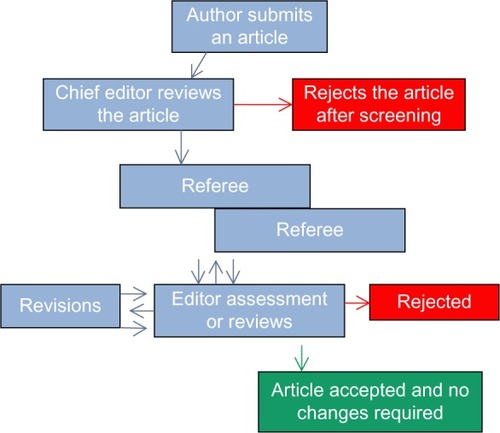Dear editor
The peer review system relies on assessment of ingenious work by other people in the same domain in order to preserve or improve the quality and creativity of the work.Citation1 Discussion and suggestions on improving the reliability of the process are made in this letter.
Peer review is like a gatekeeper in the academic world, and the methods for putting peer review into practice vary across journals and disciplines. The theory behind this system is that a larger and more diverse group of people will usually find more flaws in a work and will be able to make a more unbiased assessment of it than just the person or group who created the work. The strength and weaknesses of the peer review process have been discussed by Sollenberger in a review article.Citation2
Peer review utilizes self-governance and the anonymity of the reviewers (referees) so as to discourage cronyism (ie, bias shown to family and friends) and obtain an unbiased report. The reviewers are not selected from amongst the close colleagues/relatives/friends of the author.
The procedure of peer review is shown in . Specialists in a given field judge the professional performance, creativity, or quality of scientific work produced by others in their field or area of competence. In single-blind review, the reviewer identity is hidden to encourage unbiased comments, while in double-blind review, the author’s identity is masked from reviewers to shield against forms of social bias. Further, an “open peer” review journal may employ a “third” party, ie, someone who is neither affiliated directly with the reviewing entity nor associated with author being reviewed.
There can also be a system of postpublication open-review comments, normally mediated by the editor, that can be posted by readers and reviewers after the article has been published.
The scientific community is in search of ways to make peer review more efficient and effective. It is essential to maintain standards whilst also reducing the load on the reviewers (who are doing honorary work mostly). The process of peer review has evolved away from hard copy to a fully integrated online process, and all major journals usually accept online submissions. Thus peer review has become quicker and with a far lower administrative burden. But there is still plenty of room for improvement within the current peer review process.
Editors are made, not born, and good team work along with technological support can help them do a better job.Citation3 Thus reviewers and editors should be trained to adapt with the evolution in scientific publishing, and be aware that all digital pictures should mandatorily have attached metadata and embossed watermark.Citation4
As recommended by Jolly,Citation5 in addition, each paper can be allocated a “guardian”, who is a member of the editorial board particularly accountable for ensuring the satisfactoriness of the peer review process and providing an extra viewpoint regarding the quality of the paper. Papers should only be accepted for publication after authors have aptly addressed the queries raised by the authority (referees/guardians/editor/editorial board). Thus, in addition to peer review, multiple-point quality checks in the review process are implemented by the editor and editorial board.
Another recommendation is adaptation of appropriate ethical policies, regulation, and best practice. Authors, reviewers, and editors will be required to read and adhere to these policies, which reflect the high standards we expect in peer review. A number of organizations (such as the International Committee of Medical Journal Editors and Committee on Publication Ethics) describe these policies for the peer review process.
Disclosure
The author reports no conflicts of interest in this communication.
References
- HarrisCDBratzlerDWEvaluating quality of care: The role of peer reviewJ Okla State Med Assoc2013106727928127928424032253
- SollenbergerJFEditorial peer review: Its strengths and weaknessesJ Med Libr Assoc2002901115
- SivapathasundharamBScientific writing: The Indian scenarioIndian J Dent Res20081928718445920
- ChowdhryASircarKPopliDBTandonAImage manipulation: Fraudulence in digital dental records: Study and reviewJ Forensic Dent Sci201461313524696587
- JollyPDRe: Journal Standards – Editor’s replyN Z Vet J200351419916032326

